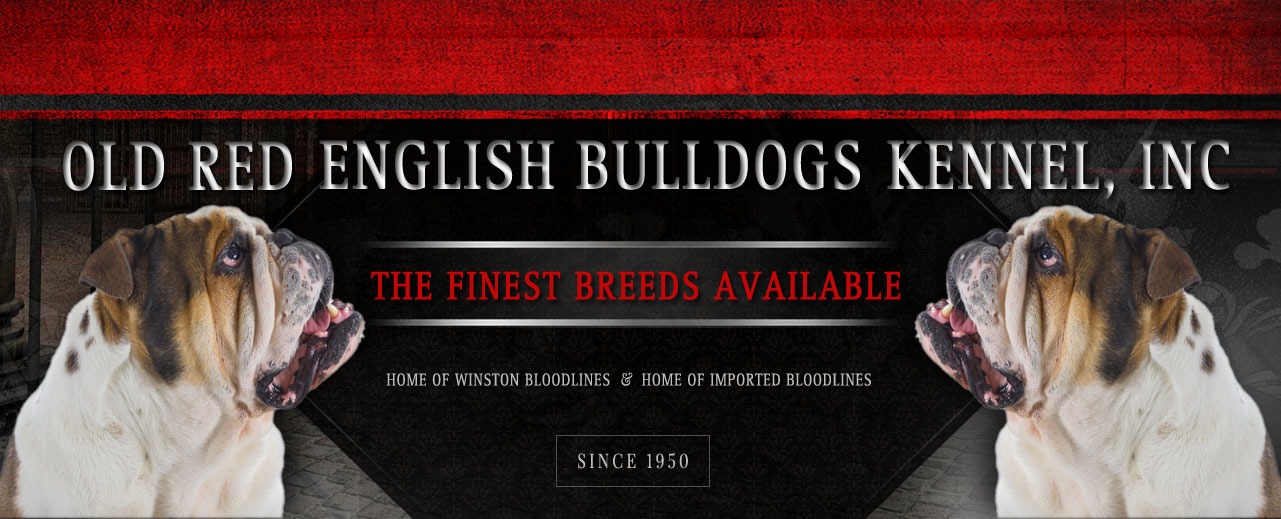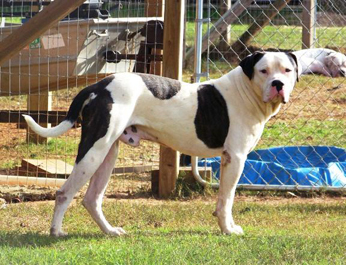The American Bulldog is one of the most variable modern dog breeds in terms of appearance. The breed displays a wide range of size, build, head size and shape, muzzle length, shape, and coloration. There are two distinct lines of American Bulldog: the Scott/Standard/Performance Type and the Johnson/Bully/Classic Type. However, these two lines have been heavily mixed, and most breed members show characteristics of both. Generally, the Johnson Type is larger, more stockily built, with a broader head and shorter muzzle, while the Scott Type is smaller, more athletic, with a smaller head and longer muzzle. Although many breed fanciers dislike this comparison, the Johnson Type American Bulldog tends to resemble the English Bulldog, while the Scott Type has more similarities with the American Pit Bull Terrier.
Regardless of type, the American Bulldog is a large to very large dog. On average, male American Bulldogs stand between 22 and 27 inches tall at the shoulder, and females stand between 20 and 25 inches. It is not uncommon for individual dogs to be up to two inches taller or shorter than this, and differences of up to four inches are not unheard of. Both types are powerful and muscular. The Johnson Type is generally bulkier than the Scott Type, but individual dogs range from sturdy yet lean to thick and tank-like. However, under no circumstances should any American Bulldog appear overweight. The weight of the American Bulldog is influenced by height, gender, build, and type, with males typically weighing between 70 and 150 pounds, and females between 60 and 120 pounds. The natural tail of the American Bulldog is long and whip-like. While the majority of owners keep the dog’s natural tail, some opt to have it docked short.
The head and face are the primary differences between the two types of American Bulldog. Both varieties have very large and broad heads, but not to the extent of the English Bulldog. The Johnson Type’s head is typically flat and square, while the Scott Type often has a slightly wedge-shaped head. The muzzle and head connect abruptly, almost at a right angle. Both the muzzle and the top of the skull should be straight and parallel. The major difference lies in the muzzle: the Johnson Type has a very short muzzle, resembling the English Bulldog, about 25 to 30% the length of the skull, while the Scott Type has a longer muzzle, similar to the American Pit Bull Terrier, approximately 30 to 40% the length of the skull. The lips of both varieties are thick and loose but not overly pendulous. Most American Bulldogs have a slight underbite, which is considered preferable, but an even bite is also acceptable.
Both types tend to have facial wrinkles, although the Johnson Type often has more. The nose is large with wide nostrils, and black is the preferred color. However, some dogs may have red or brown noses. The eyes are medium-sized and should be unobstructed by wrinkles or hair. Dark brown is the preferred eye color, although blue eyes are also favored by many fanciers. Some owners may crop the ears of their American Bulldogs, but this is strongly discouraged. Natural ears are small to medium in size and highly variable in shape and direction. They may face forward, to the sides, or even backward, and can be rose, drop, or semi-prick in shape. The overall expression of an American Bulldog is one of toughness, intensity, intelligence, and courage.
The coat of the American Bulldog is short, close, and varies from soft to prickly in texture. Ideally, the hair should be about an inch or less in length. American Bulldogs can come in any color and pattern except for solid black, solid blue, any color of merle, and tricolor (white with tan and black markings). All American Bulldogs must have some white on their coats, comprising at least 10% of their total body area. A solid black mask on the muzzle is a disqualification. In practice, most breeders and owners favor dogs with as much white as possible, and many breed members are either predominantly or entirely white. Occasionally, an American Bulldog may be born with improper coloration. Such dogs may be penalized or disqualified in the show ring and should not be bred, though they still make excellent working dogs and companion animals.

